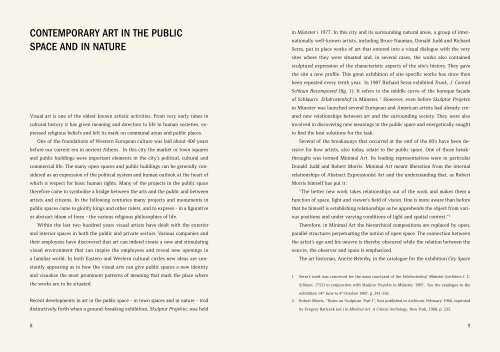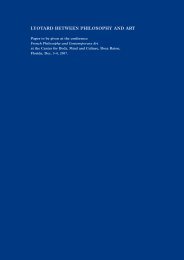to download the catalogue (pdf) - nomad academy
to download the catalogue (pdf) - nomad academy
to download the catalogue (pdf) - nomad academy
- No tags were found...
You also want an ePaper? Increase the reach of your titles
YUMPU automatically turns print PDFs into web optimized ePapers that Google loves.
CONTEMPORARY ART IN THE PUBLICSPACE AND IN NATUREVisual art is one of <strong>the</strong> oldest known artistic activities. From very early times incultural his<strong>to</strong>ry it has given meaning and direction <strong>to</strong> life in human societies, expressedreligious beliefs and left its mark on communal areas and public places.One of <strong>the</strong> foundations of Western European culture was laid about 400 yearsbefore our current era in ancient A<strong>the</strong>ns. In this city <strong>the</strong> market or <strong>to</strong>wn squaresand public buildings were important elements in <strong>the</strong> city’s political, cultural andcommercial life. The many open spaces and public buildings can be generally consideredas an expression of <strong>the</strong> political system and human outlook at <strong>the</strong> heart ofwhich is respect for basic human rights. Many of <strong>the</strong> projects in <strong>the</strong> public space<strong>the</strong>refore came <strong>to</strong> symbolise a bridge between <strong>the</strong> arts and <strong>the</strong> public and betweenartists and citizens. In <strong>the</strong> following centuries many projects and monuments inpublic spaces came <strong>to</strong> glorify kings and o<strong>the</strong>r rulers, and <strong>to</strong> express - in a figurativeor abstract idiom of form - <strong>the</strong> various religious philosophies of life.Within <strong>the</strong> last two hundred years visual artists have dealt with <strong>the</strong> exteriorand interior spaces in both <strong>the</strong> public and private sec<strong>to</strong>rs. Various companies and<strong>the</strong>ir employees have discovered that art can indeed create a new and stimulatingvisual environment that can inspire <strong>the</strong> employees and reveal new openings ina familiar world. In both Eastern and Western cultural circles new ideas are constantlyappearing as <strong>to</strong> how <strong>the</strong> visual arts can give public spaces a new identityand visualise <strong>the</strong> most prominent patterns of meaning that mark <strong>the</strong> place where<strong>the</strong> works are <strong>to</strong> be situated.Recent developments in art in <strong>the</strong> public space - in <strong>to</strong>wn spaces and in nature - troddistinctively forth when a ground-breaking exhibition, Skulptur Projekte, was heldin Münster i 1977. In this city and its surrounding natural areas, a group of internationallywell-known artists, including Bruce Nauman, Donald Judd and RichardSerra, put in place works of art that entered in<strong>to</strong> a visual dialogue with <strong>the</strong> verysites where <strong>the</strong>y were situated and, in several cases, <strong>the</strong> works also containedsculptural expression of <strong>the</strong> characteristic aspects of <strong>the</strong> site’s his<strong>to</strong>ry. They gave<strong>the</strong> site a new profile. This great exhibition of site-specific works has since <strong>the</strong>nbeen repeated every tenth year. In 1987 Richard Serra exhibited Trunk, J. ConradSchlaun Recomposed (fig. 1). It refers <strong>to</strong> <strong>the</strong> middle curve of <strong>the</strong> baroque façadeof Schlaun’s Erbdrostenhof in Münster. 1 However, even before Skulptur Projektein Münster was launched several European and American artists had already creatednew relationships between art and <strong>the</strong> surrounding society. They were alsoinvolved in discovering new meanings in <strong>the</strong> public space and energetically sought<strong>to</strong> find <strong>the</strong> best solutions for <strong>the</strong> task.Several of <strong>the</strong> breakaways that occurred at <strong>the</strong> end of <strong>the</strong> 60’s have been decisivefor how artists, also <strong>to</strong>day, relate <strong>to</strong> <strong>the</strong> public space. One of those breakthroughswas termed Minimal Art. Its leading representatives were in particularDonald Judd and Robert Morris. Minimal Art meant liberation from <strong>the</strong> internalrelationships of Abstract Expressionist Art and <strong>the</strong> understanding that, as RobertMorris himself has put it:”The better new work takes relationships out of <strong>the</strong> work and makes <strong>the</strong>m afunction of space, light and viewer’s field of vision. One is more aware than beforethat he himself is establishing relationships as he apprehends <strong>the</strong> object from variouspositions and under varying conditions of light and spatial context.” 2Therefore, in Minimal Art <strong>the</strong> hierarchical compositions are replaced by open,parallel structures perpetuating <strong>the</strong> notion of open space. The connection between<strong>the</strong> artist’s ego and his oeuvre is <strong>the</strong>reby obscured while <strong>the</strong> relation between <strong>the</strong>oeuvre, <strong>the</strong> observer and space is emphasized.The art his<strong>to</strong>rian, Anette Østerby, in <strong>the</strong> <strong>catalogue</strong> for <strong>the</strong> exhibition City Space1 Serra’s work was conceived for <strong>the</strong> main courtyard of <strong>the</strong> Erbdrostenhof, Münster (architect:J. C.Schlaun, 1753) in conjunction with Skulptur Projekte in Münster, 1987. See <strong>the</strong> <strong>catalogue</strong> <strong>to</strong> <strong>the</strong>exhibition 14 th June <strong>to</strong> 4 th Oc<strong>to</strong>ber 1987, p. 241-242.2 Robert Morris, “Notes on Sculpture. Part I”, first published in Artforum, February 1966, reprintedby Gregory Battcock (ed.) in Minimal Art. A Critical Anthology, New York, 1968, p. 232.8 9



